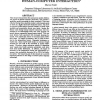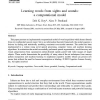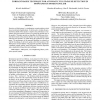105 search results - page 4 / 21 » Modeling spontaneous speech events during recognition |
NAACL
1994
13 years 11 months ago
1994
This research characterizes the spontaneous spoken disfluencies typical of human-computer interaction, and presents a predictive model accounting for their occurrence. Data were c...
CORR
1998
Springer
13 years 9 months ago
1998
Springer
In this paper, we present a method for identifying discourse marker usage in spontaneous speech based on machine learning. Discourse markers are denoted by special POS tags, and t...
COGSCI
2002
13 years 9 months ago
2002
This paper presents an implemented computational model of word acquisition which learns directly from raw multimodal sensory input. Set in an information theoretic framework, the ...
FGR
2002
IEEE
14 years 2 months ago
2002
IEEE
We present ongoing work on a project for automatic recognition of spontaneous facial actions. Spontaneous facial expressions differ substantially from posed expressions, similar t...
ICASSP
2009
IEEE
14 years 4 months ago
2009
IEEE
Detection of filled pauses is a challenging research problem which has several practical applications. It can be used to evaluate the spoken fluency skills of the speaker, to im...



